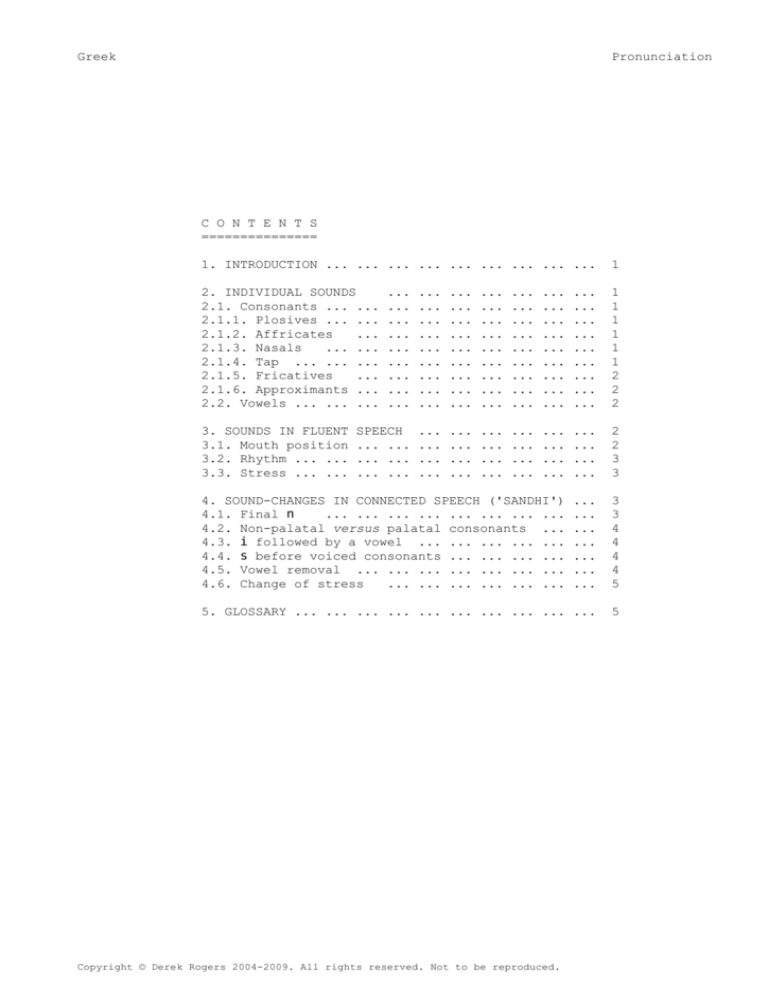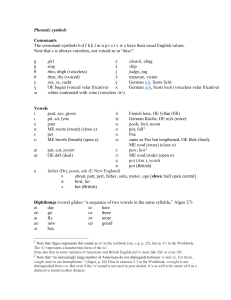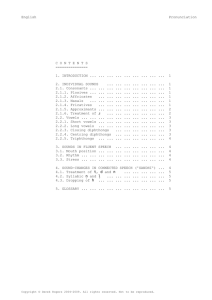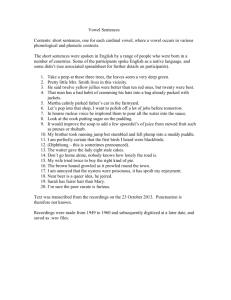
Greek
Pronunciation
C O N T E N T S
===============
1. INTRODUCTION ... ... ... ... ... ... ... ... ...
1
2. INDIVIDUAL SOUNDS
2.1. Consonants ... ...
2.1.1. Plosives ... ...
2.1.2. Affricates
...
2.1.3. Nasals
... ...
2.1.4. Tap ... ... ...
2.1.5. Fricatives
...
2.1.6. Approximants ...
2.2. Vowels ... ... ...
...
...
...
...
...
...
...
...
...
...
...
...
...
...
...
...
...
...
...
...
...
...
...
...
...
...
...
...
...
...
...
...
...
...
...
...
...
...
...
...
...
...
...
...
...
...
...
...
...
...
...
...
...
...
...
...
...
...
...
...
...
...
...
1
1
1
1
1
1
2
2
2
SPEECH
... ...
... ...
... ...
...
...
...
...
...
...
...
...
...
...
...
...
...
...
...
...
...
...
...
...
...
...
...
...
2
2
3
3
4. SOUND-CHANGES IN CONNECTED SPEECH ('SANDHI')
4.1. Final n
... ... ... ... ... ... ... ...
4.2. Non-palatal versus palatal consonants ...
4.3. i followed by a vowel ... ... ... ... ...
4.4. s before voiced consonants ... ... ... ...
4.5. Vowel removal ... ... ... ... ... ... ...
4.6. Change of stress
... ... ... ... ... ...
...
...
...
...
...
...
...
3
3
4
4
4
4
5
5. GLOSSARY ... ... ... ... ... ... ... ... ... ...
5
3. SOUNDS IN FLUENT
3.1. Mouth position
3.2. Rhythm ... ...
3.3. Stress ... ...
Copyright © Derek Rogers 2004-2009. All rights reserved. Not to be reproduced.
Greek
Pronunciation
1
P R O N U N C I A T I O N
=========================
1. INTRODUCTION
This Pronunciation module consists of this Description and a set of computerised
listening exercises: it teaches you all the speech-sounds of Modern Greek. The
variety taught is Greek as spoken by ordiinary people in southern mainland Greece.
2. INDIVIDUAL SOUNDS
2.1. Consonants
2.1.1. Plosives
p Voiceless bilabial plosive, unaspirated.
Like English p, but without the following puff of breath. ˈpamɛ we go.
b Voiced bilabial plosive.
Like English b, but with more buzz. ˈbɛɲi it goes in.
t Voiceless denti-alveolar plosive, unaspirated.
Like English t, but with the tongue pushed against the front teeth and without
the following puff of breath. ˈtɔɾa now.
d Voiced denti-alveolar plosive.
Like English d, but with the tongue pushed against the front teeth and with more
buzz. ˈdinɔmɛ I get dressed.
c Voiceless palatal plosive, unaspirated.
Like the ky sound in English cue, but without the following puff of breath.
ciˈɾia madam.
ɟ Voiced palatal plosive.
Like the gy sound in English regular, but with more buzz. tɔɲ ˈɟiɾiɔ the
gentleman.
k Voiceless velar plosive, unaspirated.
Like English k, but without the following puff of breath. ˈkaɲi it does.
g Voiced velar plosive.
Like English g, but with more buzz. tɔŋ gaˈfɛ the coffee.
2.1.2. Affricates
ts Voiceless alveolar affricate.
Like ts in English tsetse or tsunami. tsaˈbbikɔs Tsambikos (personal name).
dz Voiced alveolar affricate.
Like the dz sound in English adds up. ˈdzami window-glass.
2.1.3. Nasals
m Voiced bilabial nasal.
Like English m. ˈmɛɲi he stays.
n Voiced denti-alveolar nasal.
Like English n, but with the tongue pushed against the front teeth. nɛ yes.
ɲ Voiced palatal nasal.
Like the ny sound in English onion. baˈɲɔ swimming.
ŋ Voiced velar nasal.
Like ng in English long. ðɛŋ ˈgaɲi it doesn't do.
2.1.4. Tap
ɾ Voiced alveolar tap.
Like a very old-fashioned pronunciation of English r in very, made by tapping
the tongue against the ridge behind the teeth. ˈbiɾa beer.
Copyright © Derek Rogers 2004-2009. All rights reserved. Not to be reproduced.
Greek
Pronunciation
2
2.1.5. Fricatives
f Voiceless labio-dental fricative.
Like English f. ˈfilɔs friend.
v Voiced labio-dental fricative.
Like Engish v. ˈvaɾka boat.
θ Voiceless interdental fricative.
Like th in English thick. ˈθɛlɔ I want.
ð Voiced interdental fricative.
Like th in English this. ˈðiɲi he gives.
s Voiceless alveolar fricative.
Like ss in English hiss. ɛˈsi you.
z Voiced alveolar fricative.
Like z in English lazy. ˈzumɛ we live.
ç Voiceless palatal fricative.
Like the ky sound in English cue, but without the tongue touching the roof of
the mouth. ˈçɛɾɛtɛ hallo!
ʝ Voiced palatal fricative.
Like the gy sound in English regular, but with more buzz, and without the tongue
touching the roof of the mouth. ˈʝasu hallo!
x Voiceless velar fricative.
Like the ch sound in Scottish loch. ˈxasamɛ we have lost.
ɣ Voiced velar fricative.
Like the ch sound in Scottish loch, but with the vocal chords vibrating to give
a buzzing sound. ɛˈɣɔ I.
2.1.6. Approximants
l Voiced denti-alveolar lateral-approximant.
Like English l, but with the tongue pushed against the front teeth. ˈlɛmɛ we
say.
ʎ Voiced palatal lateral-approximant.
Like the ly sound in English million. ðuˈʎa work.
2.2. Vowels
i Close front unrounded vowel.
Like ee in English flee, but shorter. ˈinɛ is.
ɛ Open-mid front unrounded vowel.
Like e in English dress. ˈɛla come!
a Open central unrounded vowel.
Like a in English path, but shorter, and with the tongue further forward. ˈkanɔ
I do.
ɔ Open-mid back rounded vowel, lowered.
Halfway between English cot and caught. ˈɔçi no.
u Close back rounded vowel.
Like oo in English moon, but using an old-fashioned pronunciation with strongly
rounded lips and the middle of the tongue pushed down, and shorter. ˈsupa I told
you.
3. SOUNDS IN FLUENT SPEECH
3.1. Mouth position
All languages have a characteristic position of the mouth, a way of holding the
vocal organs that colours the overall sound. In Greek, the jaw is often retracted,
with little vertical movement, but the articulation is nonetheless vigorous. The
rounded vowels have strong protrusion of the lips, and this may affect the
surrounding consonants.
Copyright © Derek Rogers 2004-2009. All rights reserved. Not to be reproduced.
Copyright © Derek Rogers 2004-2009. All rights reserved. Not to be reproduced.
Greek
Pronunciation
4
vowels in French: ˈa
̃θɾɔpɔs person (the symbol ̃ means that the vowel is nasal).
This feature is not discussed further in this course.
In some varieties of Greek, final n has survived in a number of grammatical forms,
and its presence is revealed by the sandhi changes described above: ˈpinumɛn ˈuzɔ
we're drinking ouzo instead of the standard ˈpinumɛ ˈuzɔ, but ˈpinumɛ lɛmɔˈnaða
we're drinking lemonade in both varieties.
4.2. Non-palatal versus palatal consonants
The velar (i.e. non-palatal) consonants k, g, x and ɣ are followed only by central
or back vowels (a, ɔ and u); their palatal equivalents c, ɟ, ç and ʝ are followed
only by the front vowels i and ɛ. But grammatical changes - for example in the
endings of verbs and adjectives - can change a back vowel into a front vowel, and
vice versa, in which case the preceding consonant will also change:
VERB
I:
you:
he:
we:
you:
they:
have
ˈɛxɔ
ˈɛçis
ˈɛçi
ˈɛxumɛ
ˈɛçɛtɛ
ˈɛxun
depart
ˈfɛvɣɔ
ˈfɛvʝis
ˈfɛvʝi
ˈfɛvɣumɛ
ˈfɛvʝɛtɛ
ˈfɛvɣun
ADJECTIVE
Sing. masc.
Sing. fem.
Sing. neut.
Plur. masc.
Plur. fem.
Plur. neut.
bad
kaˈkɔs
kaˈci
kaˈkɔ
kaˈci
kaˈcɛs
kaˈka
Many speakers apply the same principle to the denti-alveolar consonants n and l,
changing them to their palatal counterparts ɲ and ʎ before the front vowel i (but
not before ɛ):
VERB
I:
you:
he:
we:
you:
they:
have
ˈkanɔ
ˈkaɲis
ˈkaɲi
ˈkanumɛ
ˈkanɛtɛ
ˈkanun
ADJECTIVE
Sing. masc.
Sing. fem.
Sing. neut.
Plur. masc.
Plur. fem.
Plur. neut.
good
kaˈlɔs
kaˈʎi
kaˈlɔ
kaˈʎi
kaˈlɛs
kaˈla
4.3. i followed by a vowel
Sometimes a grammatical change means that a vowel is added to a word ending in i.
In such cases, the i changes to ç or ʝ according to whether the preceding
consonant is voiceless or voiced:
ˈspiti house
ˈspitça houses
luˈluði flower luˈluðʝa flowers
Some words resist this change, for historical reasons.
4.4. s before voiced consonants
If a word ending in s is followed by a word beginning with a voiced consonant, the
s voices to z:
- ðiˈkɔs tu belonging to him (t is a voiceless consonant, s unchanged)
- ðiˈkɔz mu belonging to me (m is a voiced consonant, s changes to z)
4.5. Vowel removal
When a word ending an a vowel
the vowels is removed. Vowels
and the vowel that is removed
Disconcertingly, the stressed
surviving vowel:
ta ˈɛθɛla becomes ˈtaθɛla
tɔ ˈɛfɛɾɛ
ˈtɔfɛɾɛ
su ˈipa
ˈsupa
is followed by a word beginning with a vowel, one of
have the 'pecking order' a ɔ u ɛ i (a is highest),
is the one that is lower in the pecking order.
vowel can be removed, moving the stress to the
I wanted them
he brought it
I told you
Copyright © Derek Rogers 2004-2009. All rights reserved. Not to be reproduced.
Greek
Pronunciation
5
4.6. Change of stress
The stress in a Greek phrase cannot fall earlier than on the third syllable from
the end - i.e. not before the 'dum-di-di' position. If a word that is stressed in
the 'dum-di-di' position has an unstressed particle added to it, the stress must
change. It moves to the penultimate syllable:
tɔ pɔˈðilatɔ the bike tɔ pɔðilaˈtɔ mu my bike
ˈtɛlʝɔsɛ
finish!
tɛlʝɔˈsɛ tɔ
finish it!
5. GLOSSARY
Affricate: a plosive followed immediately by a fricative at the same point of
articulation, the two sounds coming so close together that they sound like one
sound.
Alveolar: the tip of the tongue articulates with the alveolum. See 'Alveolum'.
Alveolum: the bony ridge behind the upper front teeth.
Approximant: the articulators, by shaping the air-stream through the mouth, create
a resonance, but not a hiss.
Aspirated: followed by a strong puff of breath, as though blowing out a candle.
See 'Unaspirated'.
Back: a vowel where the back part of the tongue is tense.
Bilabial: the upper and lower lips articulate together.
Central: a vowel where the centre of the tongue is tense.
Close: a vowel where the tense part of the tongue is near to the roof of the
mouth.
Denti-alveolar: a sound in which the tongue articulates simultaneously with the
back of the upper front teeth and the alveolum. See 'Alveolum'.
Fricative: the air-stream through the mouth is made sufficiently narrow to cause
hiss, but not completely blocked.
Front: a vowel where the front part of the tongue is tense.
Interdental: the tongue is thrust forward between the front teeth.
Labio-dental: the upper front teeth articulate with the lower lip.
Lateral-approximant: the centre of the tongue touches the roof of the mouth at the
specified point; the sides of the tongue are retracted.
Lowered: a vowel where the tense part of the tongue is slightly lower than the
specified position.
Nasal: of a consonant, one in which the breath passes through the nose (the
articulators block the passage through the mouth). Of a vowel, one in which the
breath passes partly through the nose and partly through the mouth. See 'Oral'.
Open: a vowel where the tense part of the tongue is near the floor of the mouth.
Open-mid: a vowel where the tense part of the tongue is lower than halfway between
the roof and the floor of the mouth.
Oral: a vowel that is pronounced wholly through the mouth (i.e. no breath passes
through the nose). See 'Nasal'.
Palatal: the tongue articulates with the palate, the hard middle part of the roof
of the mouth.
Plosive: the air-stream through the mouth is blocked: pressure is built up and
released suddenly.
Rounded: a vowel where the lips are rounded (by pulling in the corners of the
mouth).
Tap: a consonant where one articulator touches the other briefly while in
movement.
Unaspirated: an unaspirated plosive does not have the puff of breath that
accompanies most plosives in English. See 'Aspirated'.
Unrounded: a vowel where the lips are spread, not rounded.
Velar: the tongue articulates with the velum. See 'Velum'.
Velum: the soft back part of the roof of the mouth.
Voiced: with a voiced sound, the vocal chords vibrate: the sound can be sung; if
you put your hands over your ears, you can hear a buzz; if you touch your larynx
lightly, you can feel vibrations. See 'Voiceless'.
Voiceless: with a voiceless sound, the vocal chords do not vibrate: the sound
Copyright © Derek Rogers 2004-2009. All rights reserved. Not to be reproduced.
Copyright © Derek Rogers 2004-2009. All rights reserved. Not to be reproduced.








